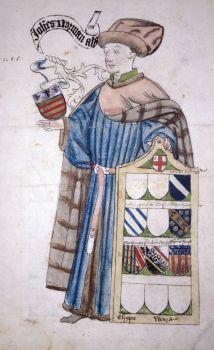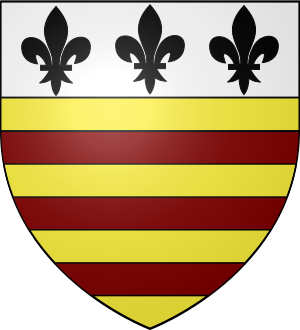John Norman (draper) facts for kids
John Norman lived a long time ago, in the 1400s. He was a successful businessman who sold cloth (a draper). He also held important jobs in London, like being a sheriff (a top law officer), an alderman (a city council member), and even the Lord Mayor of London. He's famous for being the very first Lord Mayor to travel by boat to Westminster for his official ceremony. Before him, mayors always rode horses or walked in a big parade on Lord Mayor's Day. These river parades continued until 1856. Today, the Lord Mayor rides in a special coach during the parade, which is now called the Lord Mayor's Show. John Norman even had a song made about him by the boatmen who rowed him, supposedly called "Row the Boat, Norman."
Contents
John Norman's Important Roles
John Norman was the son of John Norman of Banbury. He worked as a draper and lived in an area called Sands End. In 1443, he became a Sheriff of London and an alderman for the Castle Baynard area. He later moved to the Cheap Ward in 1448.
That same year, 1448, he asked to step down from his duties. He said he was getting old and wasn't well. He even asked that if he was nominated for mayor, someone else should be chosen instead. Despite this, Norman represented the City of London in Parliament twice in 1449. Then, in 1453, he was chosen to be the Lord Mayor of London.
The First River Parade
Once a mayor was elected, they had fifteen days to take an oath at Guildhall. The day after taking this oath, the mayor would usually ride to Westminster. There, they would be sworn in by the King or important judges. By the 1400s, this yearly parade included members of the city's special groups, called city companies. They wore their special uniforms, called liveries, and were joined by musicians. Today, this parade is known as the Lord Mayor's Show.
John Norman is believed to be the first Lord Mayor to travel to Westminster by water. People think his poor health might have been why he chose a river procession instead of the usual parade. A historian named H. Humpherus described the event. He said Norman "built a noble barge at his own expense." This barge was decorated with flags. It was rowed by boatmen using silver oars. Other city companies with their own barges joined in. The procession was so grand that "his barge seemed to burn on the water."
The river procession became very popular with the people of London. Six years after Norman's boat ride, the people asked that all future mayors travel by barge to Westminster. After Norman, all medieval mayors of London went by river to be sworn in. The special boats used in these parades are where we get the word "float" from. Today, a float is a decorated platform or vehicle used in parades or festivals. River processions for mayors continued until 1856.
The "Row the Boat, Norman" Song

According to Robert Fabyan, a Sheriff of London in the 1400s, the boatmen made a song of praise for John Norman. It supposedly started: "Rowe the bote, Norman, Rowe to thy Lemman" (which means "Row the boat, Norman, Row to your sweetheart").
A music expert from the 1800s, Edward Francis Rimbault, thought the tune for this song was the same as one published in a book of rounds by John Hilton in 1658. This same tune has appeared in other rounds, like "Turn Again, Whittington" and "Heave and Ho, Rumbelow." It's not certain which song's lyrics were the original. We don't know if the tune was first written for Norman or for Richard Whittington, who was Lord Mayor three times, starting in 1397.
It's likely that the tune was an old folk song passed down through generations. If so, according to Mary C. Taylor, it would have been natural to create new lyrics to celebrate John Norman's inauguration. This happened fifty-six years after Whittington's first time as mayor.
Later Life and Legacy
During his time as mayor, John Norman led all 165 meetings of the city's important courts. In 1462, he gained ownership of some land next to the Earl of Shrewsbury's property.
Norman passed away in 1468. He left his buildings, called tenements, to the Drapers Company. These buildings were on the north side of All Hallows Church, Honey Lane, where he was buried. He made this gift on the condition that the company pay 13 shillings and 4 pence each year to light the lane. Later, in 1473, the lands he owned when he died were taken by the city because no heir (family member) came forward to claim them.
Heraldry (Coat of Arms)
John Norman's coat of arms is shown in a portrait painted by Roger Leigh around 1450. His arms are also recorded in old documents. They are described as: gold background, with three red diagonal stripes, and a top section that is half silver and half ermine (a pattern like white fur with black spots). On the silver part, there are three black lily shapes (fleurs de lys).
However, in the mid-1800s, Bernard Burke described a slightly different version of the arms. He left out the ermine pattern, saying it was: gold background, three red bars, and on a silver top section, three black lily shapes.
See also
- Lord Mayor's Day
- Lord Mayor's Show
- Lord Mayor of London
- List of Lord Mayors of London
- List of Sheriffs of London
- City of London (elections to the Parliament of England)



